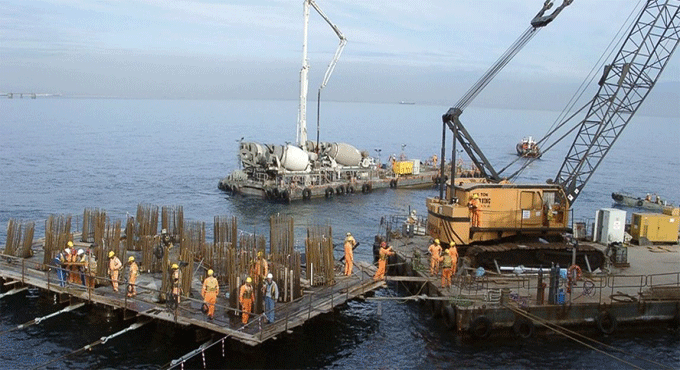
Detail information about underwater concreting
This construction article focuses on the method that is used to set concrete underwater. This method is very effective in offshore concreting as the strength of cement is reduced and faded away under water. Tremie method is most recognized method for underwater concreting.
Tremie Concrete is provided with a formwork/pipe and it contains one end of the formwork/pipe over water and other bottom end is submerged under the water with the help of gravity.
A tremie stands for a water-resistant pipe, normally having 250mm in diameter. It comprises of a funnel shape hopper at its upper end and a loose plug at the bottom or discharge end. The valve situated at the discharge end is utilized to de-water the tremie and check the circulation of the concrete. The tremie is supported on a working platform over water level and it is constructed in 1 to 3.5m section so that the placement becomes simple.
Throughout the concreting, air and water should be ejected from the tremie by retaining the pipe full of concrete all the time; and due to this the strength of the hopper should be equivalent in any case to that of the tremie pipe.
While charging the tremie, a plug made of paper is initially implanted into the pipe as the hopper occupied the pressure of fresh concrete pushes the plug down the pipe, and the water in the tremie is dislocated by concrete.
For concreting, the tremie pipe is contracted into position and the discharge end is retained as intensely immersed underneath the surface of lately arranged concrete.
As concreting continues the pipe is elevated slightly and the concrete pours outside. Precautions should be maintained for the constancy of concreting without breaking the seal arranged by the concrete cover over the discharge end. Should this seal is broken, the tremie should be lift and plugged before concreting is recommended. The tremie should not be shifted laterally via freshly placed concrete. It should be upraised vertically over the surface of concrete and transferred to its new position.
If it is required to arrange huge quantities of concrete constantly, the concrete should be arranged all together and consistently through a battery of tremies, inspite of shifting a single tremies from point to point.
It is suggested that the spacing of tremies should remain among 3.5 and 5m and that the end tremies should remain about 2.5m from the formwork. The risk of segregation and non-uniform stiffening can be reduced if the surface of concrete is retained in the forms as level as possible and by providing a incessant and hasty flow of concrete.
The method of mixing the underwater Concrete - For Structural concrete, the following should be taken into consideration :-
a. Coarse Aggregate: Gravel of 3/4? (20mm) max. size. Use 50-55 % of the total aggregate by weight.
b. Sand, 45-50% of the total aggregate by weight.
c. Cement: Type II ASTM (moderate heat of hydration), 600 lbs/yd3
d. Pozzolans: ASTM 616 Type N or F, 100 lbs/ yd3
e. Water/Cement Ratio: 0.42 (0.45 Maximum).
f. Water-Reducing Admixture (as far as possible it is also plasticizer): The superplasticizers should not be applied.
g. Air-Entrainment Admixtures: To provide 6% total air.
h. Retarding Admixture: If required, the setting time should be raised to 4-24 hours.
i. Slump: 6 1/2" ? 1"
j. This mix will produce compressive strength in the range of 5,600 ? 7,000 psi at 28 days.


